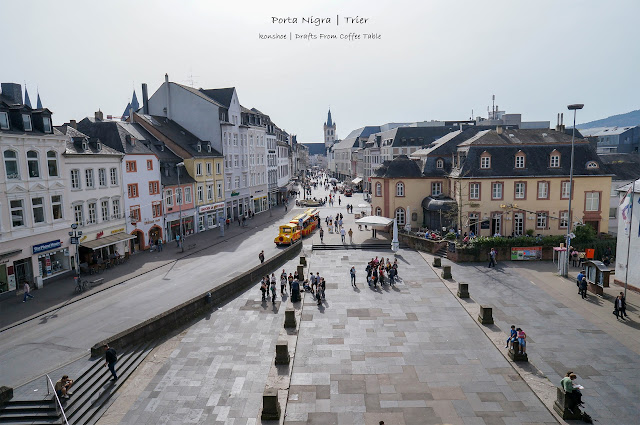Location: Trier, Germany
As the icon of Trier, Porta Nigra is a must visit point of the city even if one has no interest in history. Despite being a Roman structure, its original Roman name was lost in time, and in the Middle Ages the locals named it "Black Gate" in Latin due to its darkened exterior. Since it is the only standing gate in Trier, it was also simply called by the locals Porta.
 |
| View of Porta Nigra from north-east, or rather, the "outside". This would be the side where ancient travelers would see when they wanted to enter Trier. |
Being the largest Roman city gate north of Alps, along with the fact that it survived the ages marvelously, earned Porta Nigra an entry in UNESCO World Heritage. As aforementioned, it was the only survivor of the original four city gates, each controlling traffic through Trier during the Roman times.
The gates did not disappear due to war and ages but were pillaged and reused as building material during the Middle Ages since they were no longer used. Interestingly Porta Nigra was spared the fate of the other three gates when a Greek hermit monk named Simeon chose the building as his residence in 1028. After his death seven years later, he was buried in the gate and the building transformed into a church in honor of the monk. The two story church was named Church of St Simeon (Simeonstift) which ultimately saved it from any further destruction. Napoleon almost destroyed the church in 1803 but reordered its reconstruction later. His order was to convert the gate back to its original Roman form, and that was how it remained since.
 |
| Viewing up from the inner courtyard, a space between the outer and inner layer of the gate. The soldiers would throw tar at you if you were an ancient intruder trying to enter the city, trapping you between the gates. |
 |
| Modern travelers through an ancient gate, this would be how ancient travelers would see Trier when they were about to enter the gate. |
 |
| This side of the gate had a tower that was incomplete, with only 3 stories. |
 |
| The gate from the city center side was straight and without the rounded protrusion of towers like the outside. |
On the outside, one could see that the sandstone blocks formed a three story tall gate, held together by iron rods and without the help of mortar. On one side a four story tower stood taller than the general structure while an unfinished tower stood to the other side. Large windows lines the two tiers of defensive galleries, where invading armies could be seen and archers ready to unleash their arrows.
 |
| Porta Nigra under a blue sky |
 |
| All aboard the tourist train to Porta Nigra |
 |
| Entrance to the gate interior, right past the ticket booth |
 |
| The gate's interior at ground level |
 |
| Winding stairs |
 |
| Going up |
 |
| And up... |
 |
| Looking down at the stairs |
 |
| Lonely column |
 |
| Roman arches |
 |
| The long corridor along the interior |
 |
| Hall |
 |
| The 12th century Romanesque apse |
 |
| A preserved carving of church fathers |
After a short bout of self doubt, I decided to pay the entrance fee to see what could the gate offer within its confines. Taking a photo outside would suffice for any tourists but my curiosity was not sated until I could check the interior out. Needless to say, I was awed by the view within as it felt like I entered one of Indiana Jones or Tomb Raider's world.
 |
| Inner courtwayrd |
 |
| Does this look like a scene from some Tomb Raider game? |
 |
| A vertical view |
 |
| Corridor along the inner courtyard |
 |
| Roman arches abound in Porta Nigra |
 |
| Looking towards Trier center from Porta Nigra |
 |
| Beautiful carvings on columns |
 |
| Another hall |
 |
| Inner courtyard from a higher level |
 |
| This was how the circular tower felt like inside its top floor |
 |
| Looking towards the other tower |
 |
| They even carved the top of the arches |
 |
| A better view of Trier - notice the square bases? Those were remains of columns during Roman era. |
 |
| How Trier looked like during the Roman era from this view. |
 |
| Simeonstift, the 11th century monastery beside Porta Nigra - the church of St Simeon was within the church itself before Napoleon dissolved it. |
 |
| View of the monastery with Porta Nigra at the background |
 |
| An unobstructed view of both monastery and gate |
The gate was quite spacious and although the circuit through the gate's interior was not long, I took quite some time snapping away shots. It was quite an amazing experience to be inside, and even though it may not excite most people, I believe the ticket price was worth the experience you get.
Environment: A Roman gate defying the flow of time
Suitable for: History buffs, ruin explorers
Visit worthiness: 9/10
Historical value: 5.0/5.0
Architectural value: 4.0/5.0
Photographic value: 4.0/5.0
Landmark value: 5.0/5.0
Entrance Fee: €4 (adult); €2.50 (17 and below); refer here for more prices
Opening Hours: (Apr - Sep) daily 9.00 a.m. - 6.00 p.m.
(Oct & Mar) daily 9.00 a.m. - 5.00 p.m.
(Nov - Feb) daily 9.00 a.m. - 4.00 p.m.
Best Moment to Visit: noon when the sun shines straight down and illuminates the interior
Length of Visit: 1 - 2 hours (<1 hours without entering)
E-mail: -
Address: Porta-Nigra-Platz, 54290 Trier, Germany




































No comments:
Post a Comment